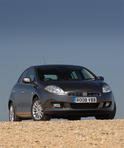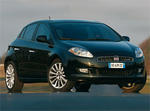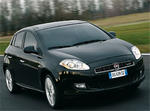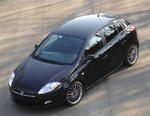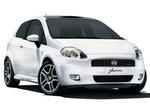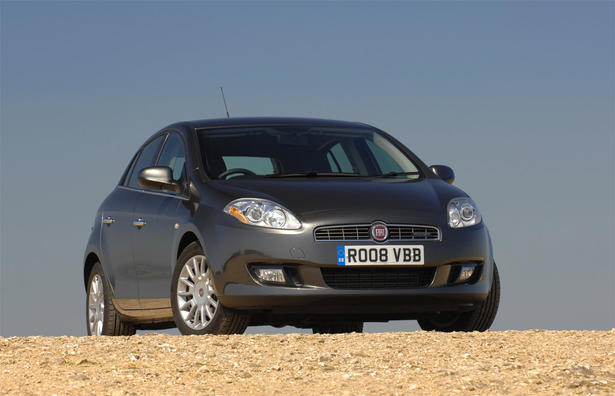
Fiat announced three new engines for the UK market version of the Fiat Bravo. Two 1.6 MultiJet versions and an Eco option. The first Fiat Bravo 1.6 16v MultiJet Eco version has a four cylinder 1598 cc engine that develops 105 bhp at 4000 rpm and 290 Nm (214 lb ft) of torque at 2000 rpm. The second version of the Fiat Bravo 1.6 16v MultiJet Eco has the same engine, but outputs 120 bhp at 4000 rpm and 300 Nm (221 lb ft) of torque at 2000 rpm.
The Fiat Bravo 1.6 16v MultiJet Eco option includes revised engine ECU settings, optimised aerodynamics, low rolling resistance tires and taller gear ratios. The 105 bhp version of the Fiat Bravo 1.6 16v MultiJet Eco offers a 62.8 mpg fuel consumption in a combined cycle and 119 g/km CO2 emissions.
For the Fiat Bravo 1.6 16v MultiJet Eco price read the press release below.
Fiat Press Release:
Three new additions to Fiat’s 5-door mid-size Bravo range – two 1.6 MultiJet versions and an Eco option – went on sale here earlier this month. These Euro 5-compliant versions join a buoyant Bravo line-up, which has enjoyed significant recognition since its introduction to the UK in June last year.
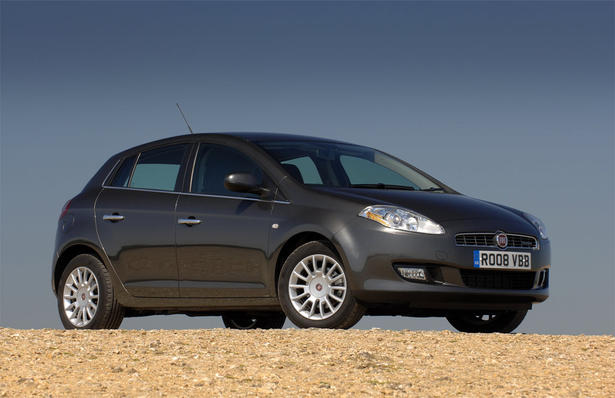
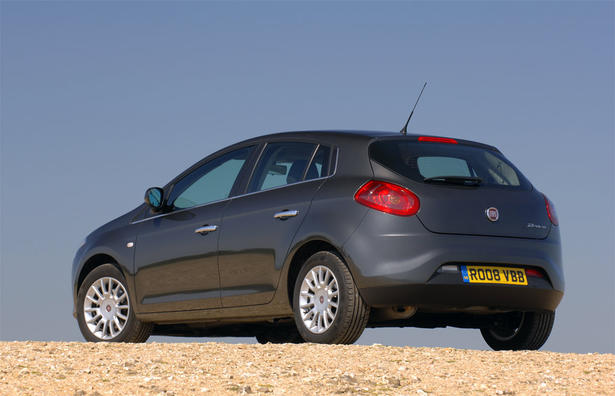
The 2007 launch marked Fiat’s return to the second largest segment of the UK market, which equates to almost 600,000 cars per year or some 25 per cent of the total. The new engines enhance existing aspects of the Bravo range – with even more impressive economy, lower running costs and notably low emissions.
There are now 17 versions in the UK Bravo range, priced from £10,995 to £16,355 on-the-road, embracing five trim levels – Bravo, Active, Active Sport, Dynamic and Sport. Augmenting an interior design founded on the fundamental pre-requisites of class-leading space, exemplary
build quality, and visual and tactile sophistication, the Bravo’s equipment specification has been carefully considered to simplify and enhance life on board. ABS anti-lock braking, remote central locking, driver and passenger front and side airbags, electric front windows, a CD player, Dualdrive electric power steering and Follow Me Home headlamps are fitted as standard, even within entry level models.
This comprehensive equipment package is further boosted by a range of innovative, safety and
comfort enhancing options such as dual-zone climate control, cruise control, rain, parking and tire pressure sensors, a SkyDome glass sunroof occupying almost the entire Bravo roof area, a CD system – with subwoofer – that can play MP3 files, and Blue & Me mobile phone and MP3 player connectivity with steering wheel controls.
The new 1.6 MultiJet engine brings the number of powerplants offered in Bravo’s UK range to six. The 1.6 has four cylinders in line, 16 valves, and a displacement of 1598 cc. Two different engines are available: the first developing 105 bhp at 4000 rpm and torque of 290 Nm (214 lb ft) at 2000 rpm; the second developing 120 bhp at 4000 rpm and torque of 300 Nm (221 lb ft)
at 2000 rpm. Both units come with a manual six-speed gearbox which generates significantly less noise at motorway speeds and facilitates reduced fuel consumption.
This new 1.6 MultiJet is also available with a special eco-package in 105 bhp form. In addition to revised engine ECU settings, this ‘Eco’ pack employs special measures to optimise aerodynamics, incorporates low rolling resistance tires and ‘taller’ gear ratios, and returns outstanding fuel consumption and CO2 figures: 62.8 mpg in the combined cycle (an increase of five mpg on the standard 105 bhp 1.6 MultiJet) and CO2 emissions of just 119 g/km.
These engines are boosted by either electronically-controlled fixed-geometry (105 bhp version) or variable-geometry (120 bhp version) turbochargers, to enhance power output while providing very high torque even at low revs. The engines are best in class for maximum torque, while specific torque output is best-in-segment for engines below 200 bhp.
Compared with the current Fiat 1.9 MultiJet 120 bhp unit, the 1.6 MultiJet series represents an important step forward – with the same power, torque is improved by almost 25 per cent at 1500 rpm, and fuel consumption is reduced by eight per cent.
The Bravo engine line-up also includes the 1.4 liter T-Jet 150 bhp turbocharged petrol engine, which made its debut in the Bravo. This is the first example of a new family of turbocharged petrol units developed by Fiat Powertrain Technologies to combine the sporting performance and low NVH characteristics of a petrol engine with fuel economy comparable to a diesel unit and CO2 emission levels which readily comply with increasingly stringent European regulation.
Through cubic capacity downsizing allied to the adoption of the smallest possible turbocharger, Fiat’s responsive 150 bhp 1.4 liter T-Jet engine combines performance equal to or better than a conventionally aspirated 1.8/2.0 liter petrol engine, but with a reduction of between 10 and 20 per cent in fuel consumption and emissions. These advantages are especially useful, given the importance of the fleet market, where taxation plays a major role.
The addition to the UK range last September of a 120 bhp version of this outstanding unit, offers performance equal to or better than a conventionally aspirated 1.6 liter petrol engine, with significant fuel consumption reductions.
Fiat’s T-Jet engines are pioneers of the downsizing philosophy which consists of a turbo compressor coupled with a smaller, lighter engine to achieve better performance with lower consumption and emissions. Fun to drive, the T-Jet engine range features lower fuel consumption thanks to higher combustion efficiency.
Bravo can also be equipped with a 90 bhp version of Fiat’s lively 1.4 liter 16-valve Fire petrol engine, as well as a 150 bhp 16-valve version of the company’s widely acclaimed 1.9 liter Common rail direct injection MultiJet turbodiesel.
These on-going developments with Bravo fit perfectly with Fiat’s plans to be an environmental leader among the world’s car companies. In 2007, Fiat Group CEO Sergio Marchionne announced his intention to push forward with plans, by 2012, to reach the lowest weighted average CO2 emission level for the cars Fiat produces, compared with its competitors.
Fiat is already the top performer in Europe for having the lowest average CO2 emissions, at 137.3g/km, according to the latest figures published by Jato Dynamics, a world leader in automotive research and information. Widely recognised as being one of the world’s ‘greenest’ car manufacturers, Fiat was also recently voted the UK’s lowest CO2 emitting car brand by CleanGreenCars.co.uk.
DESIGN
With a 5-star Euro NCAP safety rating to its name, the new Fiat Bravo builds on an already impressive safety portfolio with the full range of braking, traction control and stability systems available on the market today: ABS anti-lock brakes, complete with electronic brakeforce distribution, ASR to limit wheel spin during acceleration, MSR to modulate engine brake torque whilst changing down, and a sophisticated ESP to control vehicle stability through bends. Vehicles fitted with ESP also benefit from hydraulic brake assistance and a Hill Holder function to facilitate smooth hill starts.
Combining class-leading accommodation with exemplary build quality, flexible practicality, generous equipment levels, and state-of-the-art technology and driving dynamics, the all-new Fiat Bravo was created in just 18 months, from design ‘freeze’ to production.
To achieve this record-breaking development time, Fiat Auto employed new, groundbreaking, state-of-the-art Computer Aided Design (CAD) and Computer Aided Engineering (CAE) systems of unprecedented power and complexity. Obviating the need for inefficient, costly, and time consuming physical prototype studies other than for final ‘sign off’, the development of the new Bravo was undertaken almost entirely through virtual analysis and engineering.
Virtualisation of every aspect of design and manufacture creates a practically infinite number of prototypes which can be subjected to unlimited testing, measuring unprecedented quantities of information to explore and optimise every aspect of vehicle behaviour in the smallest detail.
So sophisticated is the computer software involved, that not only could Fiat’s engineers simulate Bravo’s structural stiffness, driving dynamics, NVH levels, aerodynamic efficiency, fuel economy, visibility zones, impact characteristics, durability and even air-conditioning functionality, but they were also able to create a virtual production-line. Virtualisation of the assembly-line included a ‘total immersion’ approach, employing virtual reality equipment to optimise on-line manufacturing techniques, whilst component supplier access to every CAD/CAE stage afforded continuous specification revision before final quality verification and manufacture.
The benefits of Fiat Auto’s ground-breaking developments in virtual design and engineering are clearly evident in every aspect of the Bravo, from consistently high build quality and class-leading passenger accommodation, to impressive driving dynamics, minimal NVH levels and outstanding safety credentials.
Styling
Designed by the Fiat Styling Center, the new 5-door Fiat Bravo marries smooth, naturally aerodynamic lines with pronounced, muscular wheel arches to create an elegant, dynamic and sporting design. New Bravo shares some of the styling cues first introduced in the highly successful Grande Punto range, making it instantly recognisable as part of a new generation of attractive family vehicles from Fiat.
The front end of the new Bravo features dynamic, assertive styling worthy of the Italian GT tradition. It incorporates sleek, powerful, teardrop headlamps with a crisp, sporting grille design, an integral, color-coded bumper and a deep front airdam complete with recessed foglight housings. Safety has been an important design consideration, and the Bravo’s wide bonnet, tapered bumper structure and rounded front profile ensure that the new Fiat is endowed with a high standard of pedestrian protection.
In profile, the bonnet and front wings flow seamlessly into a steeply raked windscreen. The resultant aerodynamic efficiency bestows enhanced high-speed stability, a reduction in wind noise intrusion to the interior, and enhanced fuel economy. Aerodynamic, door-mounted mirrors further reduce interior wind noise levels, and also emphasise the Bravo’s tapering waistline, which reinforces the smooth homogeny of the design.
At the rear, large, high visibility tail light clusters flank a practical, top hinged tailgate – with an integral roof spoiler housing the third stop light – which offers full-width access to the loadspace across a low-silled aperture. The Bravo’s broad, purposeful stance is further strengthened by an aerodynamic lower bumper, housing slender fog and reversing light clusters.
Bravo also offers a bespoke range of 16”-18” alloy wheels, and is available in a choice of 12 body colors.
Life on board
4336 mm long, 1792 mm wide, 1498 mm high and with a wheelbase of 2600 mm, the Bravo offers spacious accommodation, sound ergonomics and high quality build allied to a comprehensive equipment specification.
Painstakingly refined through the use of virtual reality ergonomic structuring techniques, the combination of a height adjustable driver’s seat with optional lumbar adjustment, rake and reach adjustable steering wheel, and generous glazing afford the Fiat Bravo driver a comfortable, ergonomically adaptable driving position allied to excellent all-round visibility.
The driver’s instrument binnacle flows seamlessly from the soft-touch, carbon look upper fascia and features deeply recessed dials with backlit graphics after dark. A clear, intuitive, central multi-function display gives access to a wide range of menu options in a choice of nine languages. Careful consideration has gone into the ergonomic placement of gear lever, steering column mounted switchgear and all other center console based functions, to ensure optimum ease of access with minimal driver distraction.
The seats, produced in accordance with principles developed by the Biometrics Department at the CONI Sport Medicine Institute, offer exceptional comfort and support, devoting particular attention to passenger posture and lateral containment.
The height adjustable, anti-submarining front seats incorporate an improved lumbar support system, and are padded with a foam that adapts to the shape of the body. They can be fitted with an anti-whiplash system, and lumbar adjustment is available for the driver’s seat. At the rear, a 60:40 split/folding rear bench offers seating for three, and may be folded flat to increase the Bravo’s loadspace from 365 liters (with spare wheel) to a capacious maximum of 1175 liters. Both outer rear seats include ISOFIX mountings for a child seat.
The Bravo’s passenger compartment is notable for both ease of access and spaciousness. Of particular note is the class-leading cabin width at shoulder height and the substantial, 240 mm longitudinal adjustment of the front seats.
Reinforcing the quality of the Fiat Bravo’s stylish interior, increased visual and tactile sophistication is offered through the high-gloss center console and air-conditioning control surrounds, and a highly innovative range of color combinations to the two-tone dashboard, including the use of soft-touch blue, anthracite, brown or black carbon look finishes. A complementary range of fabric upholstery to seats and door panels, as well as optional leather trims, offers further bespoke tailoring opportunities.
The Bravo interior is one of the most practical in its category, with a useful storage drawer under the front passenger seat, a refrigerated compartment, door pockets, a center console with space for bottles, documents, maps and coins, storage compartments on the fascia for keys, sunglasses and remote controls, and a large glovebox.
NVH
Particular emphasis has been placed on eliminating the transmission of noise vibration and harshness to the Bravo’s cabin, further enhancing on-board comfort with the quietest possible, vibration-free interior.
The extensive deployment of sound absorbing materials has been further bolstered by the introduction of numerous expandable, sound-deadening partitions located within the box sections of the Bravo’s monocoque structure, preventing noise propagation and isolating the passenger compartment from the outside world.
Vibration is limited by a particularly rigid bodyshell structure which has recorded a flexural rigidity of 960 daN/mm and torsional rigidity of 121,800 daNm/rad – outstanding results in a car with a full height tailgate. Particular attention has also been paid to the vibration-free mounting of all mechanical elements including engine, suspension and steering column.
SAFETY
Bravo has been awarded a maximum 5-star rating for adult occupant protection in the gruelling Euro NCAP crash test program. Achieving 5 stars for adult occupant safety, 3 stars for child protection and a further 2 for pedestrian protection, the Bravo recorded 33 points out of a possible 37, placing it among the leaders in its category in terms of passive, active and preventive safety.
This is an important accolade which, together with similar ratings already achieved by the Fiat 500, Grande Punto, and other Fiat Group products, is further confirmation of Fiat’s commitment to all aspects of driver and passenger protection.
To achieve this outstanding result, over 15,000 hours of computations were carried out, along with 60 crash tests, 150 simulations with the HyGe sled and 100 tests on components and subsystems, encompassing every possible type of accident: head-on and lateral collisions, rollovers, rear-end collisions and fire. Other factors taken into consideration included the different speeds at which accidents occur, obstacles, pedestrian protection, and the protection of occupants with widely differing physical attributes.
PREVENTIVE SAFETY
The Fiat Bravo meets preventive safety needs with an adjustable cockpit that adapts perfectly to drivers of any size. The combination of a height adjustable driver’s seat and reach and rake adjustable steering, allied to an extensive glazed area, allows the best possible view of the road ahead. User-friendly ergonomics allow drivers to operate all instruments and controls without taking their eyes off the road. And the Bravo’s excellent all-round visibility is further enhanced by foglights that illuminate the road around corners and the availability of optional rain, parking and tire pressure sensors.
PASSIVE SAFETY
Allied to a chassis designed to provide exceptional torsional stiffness (121,800 daNm/rad) yet absorb impact with maximum efficiency, all versions of the Fiat Bravo, with the exception of the entry level version, are equipped with six airbags, whilst height adjustable front seatbelts with pretensioner, load limiter and fastened sensor, three-point rear seatbelts, anti-submarining front and rear seats, five head restraints, ISOFIX child seat attachments to outer rear seats and an FPS Fire Prevention System are all fitted as standard.
Airbags
All versions of the Bravo, except the entry level vehicle, are equipped with six airbags fitted as standard; driver and passenger front airbags – including a driver’s dual-stage ‘Smart 2’ bag – side airbags and two side curtain airbags providing head protection in the case of side impacts. Their operation is governed by an electronic control unit that evaluates crash severity via a number of sensors located throughout the car.
The front passenger airbag may be deactivated manually via the menu on the control panel. A dashboard warning light indicates this condition.
ISOFIX Attachments
Bravo is fitted with ISOFIX mountings to ensure the easy and safe installation of child seats. The attachments take the form of two pairs of brackets located at the base of the two outer rear seat squabs. The bracket sizes and settings are in accordance with European standards so that the seat can be re-used on any other vehicle.
Fire Prevention System
The FPS includes a cut-off valve and an inertia switch which immediately locks the electric petrol pump. This prevents fuel loss in the case of impact, roll-over or damage to the fuel lines. The fuel tank is formed in a plastic resistant to mechanical stress and fire. Special care has been taken over the location of key components within the engine bay, electrical system, fuel system and brakes to minimise the risk of accidental damage. The Bravo’s interior trim is also flame resistant.
ACTIVE SAFETY
Bravo offers the full range of braking, traction control and stability systems available on the market today: ABS anti-lock brakes, complete with Electronic Brakeforce Distribution, ASR to limit wheel spin during acceleration, MSR to modulate engine brake torque whilst changing down, and a sophisticated ESP to control vehicle stability through bends. Versions fitted with ESP also benefit from hydraulic brake assistance and a Hill Holder function to facilitate smooth hill starts.
Brakes and Tyres
The servo assisted braking system features two independent crossover hydraulic circuits to ensure prompt, linear braking and shorter stopping distances.
Allied to a range of steel or alloy wheels, the new Fiat Bravo may be equipped with either 195/65 R15, 205/55 R16, 225/45 R17 or 225/40 R18 tyres, each chosen to optimise roadholding, safety and ride comfort.
ABS
An advanced ABS system, featuring four active sensors, four channels and a hydraulic control unit with eight solenoids, is fitted as standard across the entire Fiat Bravo range.
The system is complemented by an Electronic Brakeforce Distributor (EBD) that governs the braking action on the rear axle to prevent the wheels locking and ensure full control of the car in all situations. The system also adapts its operation to wheel grip conditions and brake pad efficiency to reduce pad overheating and the brake servo thrust requirement.
ASR and MSR
The new Bravo can also be equipped, as an option, with a sophisticated Anti Slip Regulation (ASR) system to restrict wheel spin in conditions of reduced grip. ASR traction control works at any speed, and prevents the driven wheels from spinning by adjusting torque according to available levels of grip.
MSR (Motor Schleppmoment Regelung) intervenes when a gear is shifted down abruptly in low grip conditions. The system restores torque to the engine to prevent a slide as a result of wheel lock-up.
Both ASR and MSR are available when ESP is ordered as an option, along with Hydraulic Brake Assist.
HBA
On Bravo versions without ESP, emergency brake assistance takes the form of Emergency Valve Assistance (EVA); a mechanical system located inside the brake servo. On vehicles fitted with ESP, the function is carried out electronically by the ABS control unit and is known as Hydraulic Brake Assistance (HBA). Both systems carry out an identical function with equal efficiency.
ESP
Bravo can be equipped with a permanently engaged Electronic Stability Programme (ESP) which activates to help control the car when its stability is at risk.
Via sensors monitoring car body rotation, lateral acceleration and steering wheel input, the system assesses vehicle stability and the proximity of either an understeer or oversteer slide. The system restores stability by applying smoothly modulated braking to the appropriate wheel individually, and simultaneously reducing engine power. Engine power reduction is also carefully modulated to ensure a minimum of performance loss and, hence, continued driver satisfaction.
Hill Holder
Fiat’s Hill Holder system helps drivers pull smoothly away from an upwards-facing hill start. Operating via the ESP longitudinal acceleration sensor when first gear is engaged and both clutch and brake pedals are pressed, the control unit maintains front calliper pressure for about 1.5 seconds after the brake pedal is released to eliminate the risk of rolling backwards and ensure a smooth pull away. Hill Holder does not operate when setting off downhill in first gear, but does so when reverse is engaged and the driver wishes to back uphill.
MODEL RANGE AND EQUIPMENT
With the 1.6 16v MultiJet Active and Dynamic versions joining the range, the new 5-door Bravo is available in 17 versions, as follows:
1.4 £10,995
1.4 Active £12,605
1.4 T-Jet 120 Active £13,105
1.4 T-Jet 150 Active £13,405
1.4 Active Sport £13,405
1.4 T-Jet 120 Active Sport £13,905
1.6 16v MultiJet 105 Active Eco £14,150
1.6 16v MultiJet 105 Active £13,855
1.6 16v MultiJet 105 Active Sport £14,655
1.4 Dynamic £13,605
1.4 T-Jet 120 Dynamic £14,105
1.4 T-Jet 150 Dynamic £14,705
1.6 16v MultiJet 105 Dynamic Eco £15,150
1.6 16v MultiJet 120 Dynamic £15,605
1.9 16v MultiJet 150 Dynamic £16,055
1.4 T-Jet 150 Sport £15,005
1.9 16v MultiJet 150 Sport £16,355
EQUIPMENT
The Bravo range is available in five trim levels – Bravo, Active, Active Sport, Dynamic and Sport. A particularly generous equipment specification has been carefully considered to simplify and enhance life on board, with ABS, air-conditioning, remote central locking, six airbags, electric front windows, a CD player, Dualdrive electric power steering, foglights and Follow Me Home headlamps fitted as standard from the Active trim level upwards.
The specification levels include the following:
Active:
Air-conditioning (not available on Bravo entry level version)
Remote central locking with deadlocks
Electric front windows
Electric door mirrors
Driver and passenger front airbags
Driver and passenger side airbags
Curtain airbags (not available on Bravo entry level version)
Height and reach adjustable steering wheel
Height adjustable driver’s seat
Follow Me Home headlamps
Dualdrive electric power steering
ABS with EBD
Stereo radio / CD player
Foglights (not available on Bravo entry level version)
Trip computer
3 rear seatbelts
ISOFIX Attachments
Active Sport:
In addition to the Active specification, Active Sport adds:
Leather sports steering wheel, gearknob and handbrake gaiter
Sport seats and interior trim
Driver’s seat lumbar adjustment
Sport pedals
17” alloy wheels
Rear spoiler and sideskirts
Chrome window strip
Front armrest
Dynamic:
In addition to the Active specification, Dynamic adds:
Electric rear windows
Leather steering wheel
Blue & Me phone and MP3 player connectivity with steering wheel controls
Driver’s seat lumbar adjustment
Dual Zone climate control
Cruise control
16” alloy wheels
Front armrest
Bespoke interior trim
Sport:
In addition to the Active specification, Sport adds:
Leather sports steering wheel, gearknob and handbrake gaiter
Sport seats
Driver’s seat lumbar adjustment
Sport pedals
17” alloy wheels
Sports suspension
ESP with ASR/MSR, HBA and Hill Holder
Rear spoiler and sideskirts
Chrome window strip
Front armrest
Cruise control
Blue & Me phone and MP3 player connectivity with steering wheel controls
Bespoke interior trim
Red brake callipers and chrome tailpipe
Sports instruments
Cornering Foglamps
Unique to this market segment, the Fiat Bravo is fitted, as standard, (except the entry level vehicle), with foglights that illuminate the road around corners. Operating at slow speeds when the vehicle’s headlights are switched on, the system automatically activates the foglight corresponding to the direction of travel when sufficient steering lock has been applied, greatly improving visibility at junctions and during parking manoeuvres.
Dualdrive electric power steering
All Bravo versions are equipped with this innovative, speed-sensitive power steering system, which comes with two operating modes and uses an electric motor, rather than a hydraulic pump driven by the engine, which results in a considerable reduction in both fuel consumption and noise.
The system offers a choice of two settings: the first ensures appropriate feedback and driver involvement, the second lightens the steering to minimise effort, and is therefore ideal for urban driving and low speed manoeuvring.
Pressing the ‘City’ button on the fascia activates the latter mode. But, to ensure maximum safety under all driving conditions, both settings offer identical power assistance over 19 mph, thus ensuring a steering wheel response suited to open road driving.
Follow Me Home headlights
A practical, safety-conscious innovation designed to light the interior of a garage or the path to one’s front door after the car has been locked, Follow Me Home activates the dipped beams and sidelights of the Bravo. The driver simply operates the light flasher stalk within two minutes of switching off the engine. Each time the stalk is operated, light activation is extended by 30 seconds up to a maximum of three-and-a-half minutes.
OPTIONAL EQUIPMENT
The new Fiat Bravo’s comprehensive standard equipment package is further enhanced by a range of innovative, safety and comfort enhancing options such as Dual Zone climate control, a SkyDome sunroof, rain and parking sensors, a tyre pressure sensor, cruise control, a CD system – with subwoofer – that can play MP3 files, Blue & Me mobile phone and MP3 player connectivity with steering wheel controls.
Blue & Me
Blue & Me is an innovative, Windows Mobile based system arising out of a joint venture between Fiat and Microsoft. The easy-to-use system employs Bluetooth technology to allow vehicle occupants to communicate with the outside world via mobile phones.
One year after its launch, the Blue & Me system is enjoying considerable commercial success and is the recipient of numerous awards, including business research and consulting firm Frost and Sullivan’s 2006 Excellence in Technology of the Year Award for European Automotive Telematics and Infotainment; and Telematic Update of Detroit’s Best Telematic Solution of the Year 2006. Furthermore, Automotive News Europe awarded the Eurostats 2006 prize to Giuseppe Bonollo, Vice President Product Portfolio Management, for the success of the system installed in Fiat Group cars.
Blue & Me is fully integrated into the vehicle, and offers a sophisticated hands-free system with voice recognition, that allows customers with Bluetooth mobile phones to make and receive calls without operating the mobile handset itself. The control keys are located on the steering wheel, and include the facility to scroll search through a mobile’s phone book, as well as muting the system for a private call. Users store their mobile number only once on the system, and a personal phone book may be transferred fully and then automatically updated whenever the system detects the mobile phone.
No voice learning stage is required, due to the state-of-the-art voice recognition system. Blue & Me is able to store up to five mobile phones simultaneously, thus permitting more than one vehicle occupant to make immediate use of the system.
In addition, the system features a USB port located on the Bravo’s centre console to facilitate the playback of music audio files via any digital system with an analogue connection, such as MP3, WMA, WAV, smart phones or a USB flash drive.
Dual Zone climate control
Dual Zone climate control makes it possible for driver and front seat passenger to select different air flows and a temperature differential of up to seven degrees on either side of the cabin.
The system uses numerous sensors to monitor both ambient temperature and solar gain within the two zones and adjust the temperature accordingly. It also operates a bi-level function whereby warmer air can be directed to the floor vents and cooler air to the dashboard vents. The system also features a highly efficient active carbon pollen filter, and an Air Quality Sensor which automatically activates the climate control recirculation function to prevent the intake of air in areas of high smog.
Sky Dome sunroof
The Sky Dome, a large, crystal-glass sunroof, occupies 1.24 square metres; some 77% of the Bravo’s total roof surface. It consists of two glazed panels – one fixed and one mobile – and two sunblinds that may be independently retracted towards the rear of the car.
Via a button adjacent to the central courtesy light, the retractable glass panel becomes a raised spoiler in the first position, thereafter sliding on aluminium guides to the fully opened position. Releasing the control button stops the movement at any required position. Both glass front panel and sunblind may be fully opened in just seven seconds.
Parking sensors
The parking sensor, which is activated whenever the ignition is switched on and reverse gear engaged, consists of four ultrasound sensors fitted in the rear bumper linked to an electronic control unit and a buzzer.
The four detectors cover the rear corners of the Bravo from a distance of less than
60 cm, and the area immediately behind the car from a distance of less than 150 cm. Proximity information is transmitted to the driver in the form of bleeps at intervals. The bleeps are emitted with increasing frequency, becoming a continuous signal when the car reaches a distance of 30 cm from any obstacle.
Tyre pressure sensor
Bravo may be fitted with a tyre pressure sensor which signals any anomalies with a bleep and an illuminating icon on the fascia display screen. The system monitors two conditions: insufficient inflation pressure, and a puncture. If one of these thresholds is breached, the warning icon is illuminated and a message appears on the display screen. In the event of a puncture, the system also emits an audible warning.
ENGINES AND TRANSMISSIONS
Bravo is currently available in the UK with a choice of six powerplants, and all engines are equipped with 6-speed manual transmissions.
Petrol Engines
1.4 16v T-Jet 150 bhp
• 1368 cc
• 4-cylinders, 16 valves
• Power: 150 bhp @ 5500 rpm
• Torque: 170 lb ft @ 3000 rpm
• Top speed: 131 mph
• Acceleration 0-62 mph: 8.2 seconds
• Fuel consumption: in town: 30.4 mpg
out of town: 48.7 mpg
combined: 39.8 mpg
• CO2: 167 g/km
1.4 16v T-Jet 120 bhp
• 1368 cc
• 4-cylinders, 16 valves
• Power: 120 bhp @ 5000 rpm
• Torque: 152 lb ft @ 1750 rpm
• Top speed: 122 mph
• Acceleration 0-62 mph: 9.6 seconds
• Fuel consumption: in town: 32.5 mpg
out of town: 50.4 mpg
combined: 42.2 mpg
• CO2: 158 g/km
The 120 bhp and 150 bhp 1.4 litre 16 valve T-Jet engines are the first examples of a new family of turbocharged petrol units developed by Fiat Powertrain Technologies to combine the sporting performance and low NVH characteristics of a petrol engine with fuel economy comparable to a diesel unit and CO2 emission levels which readily comply with increasingly stringent European regulation.
Through cubic capacity downsizing allied to the adoption of the smallest possible turbocharger, Fiat’s responsive new 120 bhp and 150 bhp 1.4 litre T-Jet engines combine a performance equal to or better than a conventionally aspirated 1.6/1.8/2.0 litre engine with a reduction of between 10% and 20% in fuel consumption and emissions.
Employing state-of-the-art computer aided design and calculation systems to simulate unit stress under turbocharging, every aspect of the 1.4 litre powerplant has been re-evaluated. Three-dimensional computational fluid-dynamics studies of the entire thermodynamic cycle, injection phase and the engine cooling circuit, as well as thermo-mechanical analysis of cylinder head, block and piston stress, resulted in comprehensive redevelopment of the combustion system, intake and exhaust manifolds, camshaft profiles and phasing, intake system, engine coolant circulation and spark plugs.
Fiat Group’s widely acclaimed T-Jet engines feature optimised intake port and manifold design; a revised injection system and bespoke spark plug design to improve knock resistance and pre-ignition; a reduction in both inlet and exhaust valve lift time to optimise air mass flow; a reduction in compression ratio from 11:1 to 9.8:1; piston, connecting rod and crankshaft redesign; a new, reduced volume exhaust manifold for maximum exploitation of exhaust pulse energy, and improved engine cooling efficiency through a revised coolant path and a redesigned water pump impeller.
Excellent combustion characteristics have allowed for the adoption of a notably small turbocharger. With a turbine diameter of only 33 mm, this highly compact and responsive turbine is located directly above the exhaust manifold, with the attendant catalytic converter close-coupled to the turbine exit.
Via a ‘drive-by-wire’ throttle system, Fiat’s 1.4 litre T-Jet engines provide outstanding low-end torque, almost entirely devoid of the lag in power delivery traditionally associated with turbocharger installations.
The 150 bhp T-Jet engine offers identical torque delivery in all Bravo versions at 1750 rpm but, via an ‘overboost’ button located on the centre console in Sport versions, will deliver an impressive 170 lb ft at 3000 rpm, endowing the Bravo with a 0-62 mph acceleration time of 8.2 seconds and a top speed of 131 mph. Notwithstanding such lively performance, this responsive powerplant will still return nearly 40 mpg in the combined cycle and restrict CO2 emissions to just 167 g/km.
1.4 16v Fire
• 1368 cc
• 4-cylinders, 16 valves
• Power: 90 bhp @ 5500 rpm
• Torque: 94 lb ft @ 4500 rpm
• Top speed: 111 mph
• Acceleration 0-62 mph: 12.5 seconds
• Fuel consumption: in town: 32.5 mpg
out of town: 50.4 mpg
combined: 42.2 mpg
• CO2: 158 g/km
Developed for the Fiat Bravo application to optimise a balance of performance and fuel efficiency –two areas in which Bravo leads its class – the revised 1368cc 16 valve Fire unit has a bore of 72 mm and stroke of 84 mm. It now employs a ‘drive-by-wire’ throttle system, a higher, 11:1 compression ratio, lighter timing components, low friction valve springs, a ‘flexible’ flywheel that reduces the transmission of engine vibrations to the bodyshell, and a new, high turbulence combustion chamber. The latter, allied to continuously variable valve timing, allows a significant part – some 25% – of the exhaust gases to be recirculated within the combustion chamber, offering marked reductions in both fuel consumption and exhaust emissions.
The 90 bhp unit also adopts a new, torque-based engine control unit which operates through a single coordinator block, the governing parameter of which is the torque demanded by the driver’s throttle inputs. Translated into physical torque value, the various system demands (including those of external systems such as ABS) can be coordinated even before the main engine control parameters have been converted (ignition advance, throttle valve position, injection timing, etc.), with the significant advantage of being able to generate them rapidly and with great precision. The use of torque as a single communications standard between the various systems and functions achieves a level of driveability superior to that available from current, conventional systems, whilst also further reducing emissions.
The Euro 4 compliant, 1.4 litre 16 valve Fire engine also features a catalytic converter welded directly to the side of the exhaust manifold to minimise the delay in reaching optimum operating temperature and, hence, reduce cold start emissions.
The MultiJet engine: a breakthrough in diesel technology
The Common rail high pressure direct injection diesel fuel system was designed and initially developed by the Fiat Group in the 1980s, with contributions from Magneti Marelli and the Fiat Research Centre. It was handed over to Bosch for the final stages of development and industrial production in the early 1990s, and the first car to use the new system was Fiat Group’s Alfa Romeo 156 JTD in 1997.
JTD revolutionised diesel engine design, allowing Fiat JTD units to set new dynamic standards and compete head-on with petrol engines across nearly all criteria, whilst still retaining the core diesel values of reliability, low maintenance, reduced CO2 emissions and exceptionally low fuel consumption figures.
In 2002, Fiat Group was awarded the prestigious Economist Innovation Award (Energy and Environment category) for its ground-breaking work in developing the ‘Common rail’ diesel technology that is now used by almost every major European car maker.
The sophisticated MultiJet technology of second generation JTDs differs from its UniJet predecessor in two essential areas; the injectors and the electronic control unit.
Within a UniJet engine, a pilot injection raises temperature and pressure inside the cylinder to improve combustion at the time of the main stroke. However, by dividing the main injection into a number of smaller injections, a MultiJet engine affords a fuller, more gradual combustion whilst the amount of diesel burnt at each stroke remains the same; thus abetting smoother, quieter combustion, reduced emissions and increased performance.
To facilitate multi-injection, the injectors can both reduce the time lag between injections from 1500 to just 150 microseconds, and reduce the minimum quantity of fuel injected from 2 to less than 1 cu mm. In tandem, the new control unit modulates injection strategy continually to adjust to changes within three parameters; engine rpm, torque required at any given time by the driver, and coolant temperatures.
Thus, when coolant temperature is less than 60 degrees and torque requirement low, two small and one large injection are performed. As torque demand increases, the number of injections drops to two; one small and one large. Under conditions of high rpm and high torque demand, only one injection is required, whilst with coolant temperature at over 60 degrees, emissions are minimised with one small, one large, then one small injection in the sequence.
Hence, whilst performance is substantially enhanced, start-up times and exhaust smoke are reduced, noise levels and vibration are lowered to ensure a quieter drive and improved passenger comfort, and both fuel consumption and emissions are significantly reduced. All Fiat MultiJet turbodiesel units easily fulfil Euro 4 emissions requirements.
1.9 MultiJet 16v
• 1910 cc
• 4-cylinders, 16 valves
• Power: 150 bhp @ 4000 rpm
• Torque: 225 lb ft @ 2000 rpm
• Top speed: 130 mph
• Acceleration 0-62 mph: 9.0 seconds
• Fuel consumption: in town: 37.2 mpg
out of town: 62.8 mpg
combined: 50.4 mpg
• CO2: 149 g/km
The 150 bhp 16 valve version of Fiat’s proven 1.9 litre MultiJet turbodiesel has undergone significant changes to increase performance and bottom end torque, whilst further reducing noise levels and vibration.
The Common rail system includes two new control strategies for automatically calibrating and balancing the diesel injection, to lower noise and reduce vibration. The engine is equipped with electronically controlled, variable geometry Garrett VGT 17 turbochargers for improved power delivery and the generation of high torque at low engine speeds. The unit delivers 90 per cent of peak torque between 1750 rpm and 3250 rpm.
With a bore of 82 mm and stroke of 90.4 mm, the 150 bhp 1.9 litre MultiJet unit in the New Bravo boasts an impressive 225 lb ft of torque delivered at just 2000 rpm, allowing acceleration from 0-62 mph in just 9.0 seconds and a top speed of 130 mph, whilst returning a fuel consumption of over 50 mpg in the combined cycle.
Fully compliant with Euro 4 emissions requirements, the 150 bhp powerplant displays exceptional environmental credentials. With CO2 emissions of just 149 g/km, this sophisticated MultiJet unit incorporates an electronic EGR system which cools the recirculating exhaust gases, and a close-coupled, high efficiency catalytic converter.
1.6 MultiJet 16v
• 1598 cc
• 4-cylinders, 16 valves
• Power: 105 or 120 bhp @ 4000 rpm
• Torque: 214 or 221 lb ft @ 2000 rpm
• Top speed: 116 or 121 mph
• Acceleration 0-62 mph: 11.3 or 10.5 seconds
• Fuel consumption: in town: 44.8 / 48.7 (Eco) / 44.8 mpg
out of town: 63.8 / 74.3 (Eco) / 68.8 mpg
combined: 57.6 / 62.8 (Eco) / 57.6 mpg
• CO2: 129 / 119 (Eco) / 129 g/km
This new diesel engine, introduced initially for use in the Bravo range, and available in two states of tune – either 105 or 120 bhp, has again demonstrated Fiat Group’s commitment to the production of increasingly environmentally-friendly vehicles.
Fiat’s new 1.6 MultiJet 16v unit offers sparkling performance, outstanding torque, increased noise suppression and lower running costs for the Bravo range. The addition also makes Bravo the first car in its category to be fitted with a Euro 5-compliant engine, well ahead of the 2009 deadline.
The new Bravo 1.6 MultiJet is also available with a special eco-package in 105 bhp form. In addition to revised engine ECU settings, this ‘Eco’ pack employs special measures to optimise aerodynamics, incorporates low rolling resistance tyres and ‘taller’ gear ratios and returns some outstanding fuel consumption and CO2 figures: 62.8 mpg in the combined cycle (an increase of some 5 mpg on the standard 105 bhp 1.6 MultiJet) and CO2 emissions of just 119 g/km.
This figure will assist in Fiat Group’s pledge to be the leading manufacturer in terms of weighted average CO2 levels. Last year, Fiat Group CEO Sergio Marchionne told the international media that: “regardless of what other car makers will do, our Group is committed, by 2012, to reaching the lowest weighted average CO2 emission level for the cars it produces, with respect to competitors.”
Fiat is currently the top performer in Europe for having the lowest average CO2 emissions, posting 137.3 g/km in 2007, according to figures published by Jato Dynamics, world leader for consultancy and research in the automotive field.
Fiat Group’s new 1.6 MultiJet has four cylinders in line, 16 valves, and a displacement of 1598 cc. Two different engines are available: one developing 105 bhp at 4000 rpm and torque of 290 Nm (214 lb ft) at 2000 rpm; the other developing 120 bhp at 4000 rpm and torque of 300 Nm (221 lb ft) at 2000 rpm. Both engines come with a manual six-speed gearbox.
These engines are boosted by either electronically-controlled fixed-geometry (105 bhp version) or variable-geometry (120 bhp version) turbochargers, to enhance power output while providing very high torque even at low revs. Compared with the current Fiat 1.9 litre MultiJet 120 bhp unit, the 1.6 MultiJet series represents an important step forward – with the same power, torque is improved by almost 25 per cent at 1500 rpm, and consumption is reduced by eight per cent.
Another factor in the improved all-round performance is the high pressure multi-injection system, which goes from 1300 bar in the 1.9 MultiJet to 1600 bar in the 1.6 MultiJet (in both power versions). The injectors adapt to engine speed, thus optimising performance in terms of perceived power and driveability.
Heritage
FIRE – the FIRE (Fully Integrated Robotized Engine) was a revolutionary petrol engine of its time. It was designed by Fiat to be assembled on fully automatic lines, with the number of components reduced to half that of traditional engines. The FIRE engine range was introduced in the mid-80s: it was smaller than a similar capacity traditionally assembled engine, had a lower weight, and offered reduced fuel consumption, easier maintenance and superior reliability. Millions of engines have been sold to date. Today, it’s the turn of the 1.4 T-Jet 16v Turbo to once again introduce smart innovation to the automotive petrol engine sector.
Common rail – a leading player at FIAT in the evolution of the diesel engine in the last 20 years, thanks to a series of continuous innovations:
1986: Launch of the Croma TDI, the world’s first direct-injection diesel in a production saloon.
1990: Start of UniJet development based on the Common rail principle. The final stages were handed over to Robert Bosch because of its development of injection systems.
1997: The first Common rail engine in the world was installed in an Alfa 156 JTD. This revolutionary turbodiesel guaranteed performance previously unimaginable.
2002: Fiat Group Automobiles presented the second generation of JTD engines with multiple injection and 16 valves: MultiJet. The first MultiJet engine (1.9 MultiJet 16v) was launched in the same year.
2003: The revolutionary 1.3 MultiJet 16v is introduced on the new Fiat Panda. It becomes the smallest and most advanced second generation Common rail direct injection turbodiesel in the world. More than two million units have been built to date.
2004: The powerful 200 bhp 2.4 MultiJet 20v arrives.
2005: Fiat wins the prize for Engine of The Year 2005 in the 1.0-1.4-litre category. Today, it‘s the turn of the new 1.6 MultiJet 16v to reaffirm Fiat’s leadership in this sector.
Transmissions
Though they differ in terms of the maximum torque values they can handle, every gearbox in the Fiat Bravo range shares a dual cable external control that filters engine vibrations transmitted to the gear lever. Gear ratios are ‘long’, to ensure good fuel economy, whilst the clutch is hydraulic to promote ease of use, efficiency and low operating noise. On MultiJet versions of the Bravo, the system automatically compensates for clutch plate wear, ensuring a constant clutch pedal loading throughout vehicle life.
RIDE AND HANDLING
The Fiat Bravo employs the proven combination of independent MacPherson strut front suspension and a lightweight torsion beam axle at the rear, to promote outstanding handling precision and maximum ease of driving, allied to optimum road holding and the highest possible comfort standards for driver and passengers.
Allied to a bodyshell of class-leading torsional rigidity, new Bravo features a 20 mm wider track and larger tyres than its predecessor to maximise agility and promote outstanding stability under all conditions. Numerous revisions to both front and rear suspension systems – including modified geometry, re-tuning of springs and dampers, and a new front anti-roll bar – have been designed to minimise the transmission of noise and vibration, whilst further enhancing both cornering balance and ride comfort.
Front suspension
The Bravo’s front suspension is an independent, MacPherson strut system, which delivers high levels of ride comfort and driving safety, along with exceptional grip and minimal roll.
Key elements to the revised set-up comprise:
Oversized right-angled lower link geometry, which separates braking and cornering loads for optimum balance under all conditions.
‘Dual-path’ double front strut mounts to enhance structural rigidity, steering precision and minimise road transmitted vibration.
Pressed sheet metal twin-shell wishbones effecting a significant weight reduction
A stiffened anti-roll bar with shock absorber anchorage rods for enhanced stability and greater responsiveness during cornering.
A high rigidity crossbeam with a transverse linking strap close to the front link attachments.
Rigid upper strut attachment to the bodyshell with increased caster angle, to enhance steering precision, minimise vibration and improve acoustics.
Dual rate dampers with revised valve units (22 mm diameter on MultiJet versions and 20 mm on 1.4 litre petrol versions), to optimise vibration damping and enhance lateral rigidity for improved roadholding.
New optimum thrust axis coil springs to minimise internal friction and improve minor road surface imperfection absorption.
Rear suspension
At the rear, the Fiat Bravo employs a lightweight, torsion beam axle configuration featuring new springs, dampers and bushing. To maximise ride comfort, driveability and handling performance, it benefits from the following features:
A new, hollow, 40% stiffer anti-roll bar to improve handling precision and roadholding.
Vertical damper mounting for minimal vibration with improved cabin acoustics.
Hydraulic axle anchorage bushes, for enhanced longitudinal flexibility under load and greater responsiveness when cornering.
Dualdrive electric power steering
All Bravo versions are equipped with this innovative, speed-sensitive power steering system, which comes with two operating modes and uses an electric motor, rather than a hydraulic pump driven by the engine, which results in a considerable reduction in fuel consumption and transmitted noise.
The system offers a choice of two settings: the first ensures maximum feedback and driver involvement, the second lightens the steering to minimise effort, and is therefore ideal for urban driving and low speed manoeuvring.
Pressing the ‘City’ button on the fascia activates the latter mode. But, to ensure maximum safety under all driving conditions, both settings offer identical power assistance over 19 mph, thus ensuring a steering wheel response suited to open road driving.
The new Fiat Bravo has a best-in-class turning circle of 10.4 meters between kerbs and 11.0 meters between walls.
